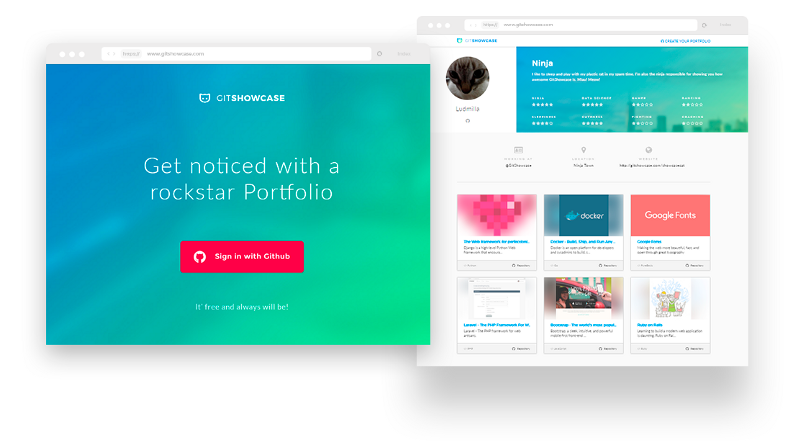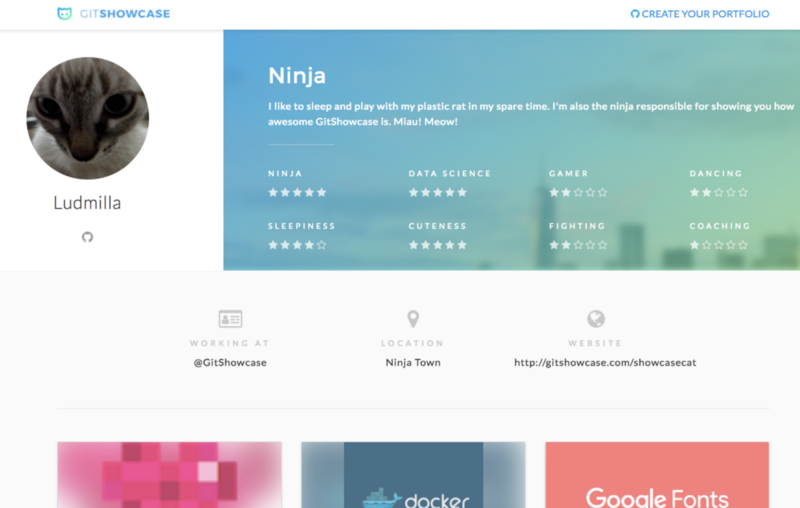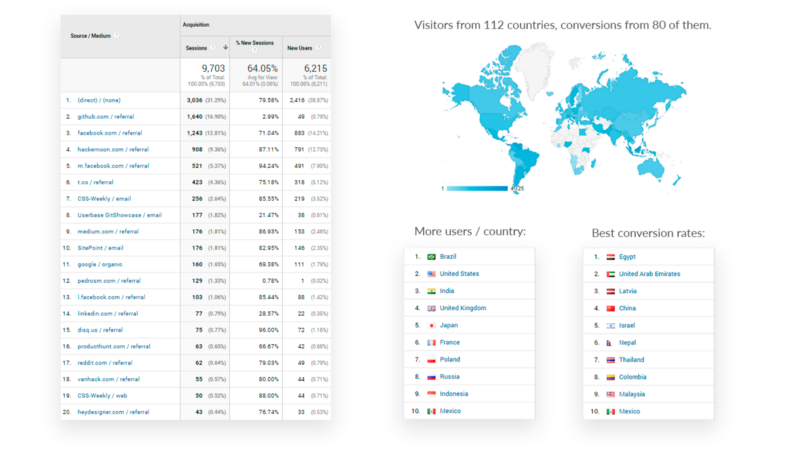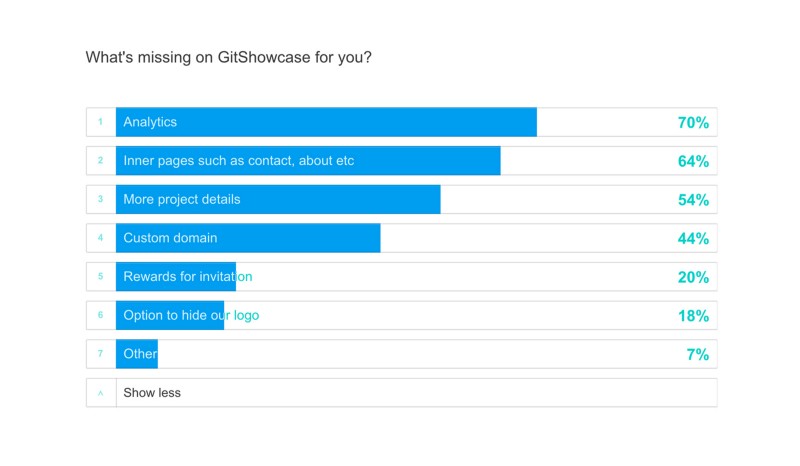by Victor F. Santos
We just launched an open source product. So what happens next?

Last month me and the ninja god Pedro launched GitShowcase, a plug-and-play portfolio for developers. Open source and free.
It’s quite simple what the product does. It fetches GitHub user info and projects to craft an one-page layout, just like this.

In this post I’ll talk about how we got over 25,000 projects showcased from 80 different countries in a single month, and how we expect to earn money from it. We hope it to be of some help for the product people and enthusiasts out there. Let’s go open source! :)
Why we made GitShowcase
Developers are amazing crafters. No one would disagree. But when applying to new jobs, most of them struggle to find a good way to present their work. Usually they look for pre-made templates or a custom CMS (Content Management System) tools to develop their personal websites.
We made it simple for developers in a rush. No hard sign-ups, no forms to fill, no code. Just a button to sign in with a GitHub account. After a one-click sign-in, all relevant info and projects are displayed in an easy, customizable one-page layout.
I was responsible for the design and Pedro for the engineering. Ironically GitShowcase was meant to be only a side project to put on our portfolios and that’s it, but community drove us other way…
The community embrace
We published GitShowcase in a few Brazilian development groups of Facebook to gather feedback. We were overwhelmed by a lot of awesome people engaging with the posts and endorsing it to friends.
Within just a few hours, we already had over 4,000 projects showcased on the platform. The most surprising part was that many of them were not from Brazil.

Our growth strategy
We were a little scared by the numbers. How were we going to keep up this rate of growth? We had no budget to make ads, nor to promote the website any other way than organically.
We focused our efforts on three pillars to see how it would perform:
- Social media ─ The source that made us visible to the world. We kept publishing GitShowcase on other groups via Facebook, LinkedIn, and reaching out to tech influencers on Twitter to have GitShowcase tested. We also put share buttons more visible and actionable on the pages.
- Content marketing ─ Pedro likes to write about tech life. So he started writing about GitShowcase, such as our tech stack, process, shipping etc., and publishing them on Hackernoon and other blogs. Check his Medium if you’re interested in shipping apps.
- SEO ─ This is a more long-tail strategy. We thought about the keywords we want to be well ranked for: “developer portfolio”, “github portfolio”, “developer website”, so users can find us organically through Google search. For the profiles, we prepared dynamic keywords: “gitshowcase + username”, “developer portfolio + username”, to get specific user searches linked to our website too. We also spread the GitShowcase link under comments of famous blog posts to work on our link building (and to get some curious scrolling readers to meet us too).
So, how the strategy performed?

The data above represents:
- On the left: sessions per source. We will identify which of the initiatives brought more visitors to the website.
- On the right: infographic about traffic per country. We will see how people from different countries visited the website, how many signed up, what’s the top 10 countries with more sign ups and what’s the top 10 countries with the best conversion rates.
Before diving in, it’s important to state that both “(direct) / none” and “Github.com / referral” are quite misleading the data. We won’t include them in the analysis because it’s confusing even for us, here’s why:
- (direct) / none ─ This source should stand for people that directly type gitshowcase.com on browser and hit go, but Google Analytics has a bug on it since always and takes credit of the traffic from other sources because of tracking failure. You can read more about it here.
- Github.com / referral ─ We use the GitHub API to authenticate the user, so it takes credit as the traffic source when it sends back to GitShowcase.
We’ll take out the misleading data now so you can look at more precise data points.

This looks better.
Here is how the three pillars contributed to the traffic generation:
Social media: 2,429 sessions (50% traffic);
Content marketing: 1,084 sessions (22.3% traffic);
SEO: 235 sessions (4.8% traffic).
Oh, wait. What about the other 22.9%?
They are our email marketing traffic (3.6%) and referrals (19.3%). Referrals are other websites with links to ours. This is something we didn’t map at first when making the strategy, other people linking GitShowcase into their pages and newsletters.
It surprised us positively because we were featured in really cool websites, such as Product Hunt. We were hunted by a nice Israeli guy named Raz. Thanks, man! Check GitShowcase on Product Hunt.
Something on our radar now are referrals, which are becoming our 4th pillar — getting other websites to talk about us and endorse us.
Social media nailed it as the best source to drive traffic, as we expected. It’s where users share their profiles and discuss the the tool, tweet it, endorse it, and others can meet us.
Content marketing was quite expressive too. People pay attention to good quality content and reward it with their time.
SEO is still a baby, because we are building our brand awareness and reputation with search engines. We think it will become more effective over the next 3 months or so.
Ok, we got some sign-ups from awesome people worldwide and some websites are talking about us. Now, how to make money out of it?
That’s where we are in this moment. As the base grows, users start making a lot of suggestions and asking for more features. We iterate the product on a daily basis when we’re home after our full-time jobs. It’s kinda driving us sleepless. So we thought: “Would it be, let’s say, maybe… the right call to monetize GitShowcase?”

We have a couple ideas about how to make GitShowcase a freemium product. In other words, people could use the basic plan for free, and get some exclusive features through paid plans. Our basic plan would be the same as it is today — a full and automated portfolio. Paid plans would have the same, along with some extras:
- A custom domain ─ www.username.com instead of https://www.gitshowcase.com/username
- Access to premium templates ─ Handcrafted templates for different focus. Today we have only one template, which is focused primarily on projects.
- Recruitment area benefits ─ Developers need portfolios mostly for job applications, or to be headhunted, so building a recruitment area seems like a no-brainer. Recruiters would be able to search our database to find developers with specific knowledge, and those on paid plans would appear higher up in results than those who are on the basic plan.
Time to survey
Before spending any time developing the features, we made a survey with our users to understand if these ideas would resonate to their interests. We used Mailchimp to send the email and Typeform to activate it.
“What’s missing today?”

Wow, analytics and generic inner content? We just put these options there to fill space, but apparently they’re what most people want.
This is why listening to users is important. We are very biased by what we think is a priority.
“Would you pay for those?”

I must confess we were expecting more enthusiasm here, even when we know it’s hard to ask for people to abstract and imagine them paying for something they can’t yet see or interact with.
Well, maybe is not that bad… Right? *holding tears*
I have heard once that companies should listen more to the extreme users of both ends — the haters and the lovers. This is where you can see serious mistakes, and you can see how you are adding real value to people’s lives. Neutrals won’t bother telling you much, because they don’t hate nor love you, so it mostly gets you in the same place. Makes sense, I guess…
“What could be a service worth paying for?”
This was the last question of the survey. It was open, more abstract than the others and not required, so many people just passed it blank. 29% spoke their mind. I will try to condense the answers on three personas:
Hater: I might have signed up, but don’t even try to charge something, I can develop my own portfolio if I want to, you obnoxious capitalists!!!!
Neutral: It’s ok to charge something, but how about a symbolic $1 per year just to have access to GitShowcase? It’s fair to help you pay the bills.
Lover side: I like the custom domain thing and would pay for it. The portfolio is really cool. But guys, have you thought about getting us closer to recruiters? Man, that’s something that would make me to tattoo the GitShowcase logo on my leg.

This was way more revealing than the other closed questions. We won’t make much progress on tiny specific things that developers can code themselves. Custom domains are still a thing because some people would like their GitShowcase profile to be their official website.
What got us really wondering is that we had plans for a recruitment area to happen in the future, but we didn’t put that in the survey because we thought it to be a really distant step. But some users are already expecting it to happen. TODAY. And they are on fire.
Do recruiters have interest on GitShowcase?
I’m looking into this. I spammed some high level tech recruiters in my network with a couple questions to see which tools they use currently, how they research candidates before approaching them, and whether they’re interested in a place to hunt developers by specific knowledge, location, and projects.
Three answered back. All of them had positive feedback about the prospects of using our platform.
Do you know a tech recruiter? Tag him/her in the comments please. We are very open to count on them to help us shape GitShowcase.
What are we going to do next?
Well, it seems now we have a plan. And tons of homework. We decided to prioritize the tasks by balancing relevance and ease of implementation. So, this is what we will grind out over the next three months:
- Custom domain functionality
- Modular templates to enrich profile content
- A talent recruitment area
Why did I just tell you all my plans?
We embrace the open source culture. Even when the common sense might say otherwise, we believe transparency builds trust, while secrecy repels it. People shouldn’t be afraid of sharing knowledge and speaking openly about their plans.

The lessons we’ve learned so far:
- Open source is love. Open source is life.
- People won’t steal the code because it’s open. In fact, people help building the product. Fork our project on GitHub and help us too.
- Content marketing performs well if the content is relevant and published in the right places.
- If you aren’t sure of something, just ask. Don’t try and fake anything that your users depend on.
- If your product doesn’t solve a real problem, there’s no strategy that can save it. Build a good product, and do some marketing to take your product places.
Liked the post? Help us by tagging a developer or a tech recruiter in the comments :)
We are a two-man band with zero budget trying to make things happen, so all the support is more than welcome. You can either:
- Tag a developer in the comments to meet GitShowcase
- Tag a tech recruiter to take a look at what we’re doing here. We’ll be opening the talent recruitment dashboard on beta soon.
- Like, comment and share this post to help it reach out more interesting people just like you.
If you are still reading this, you’re the best. Thanks for your time.